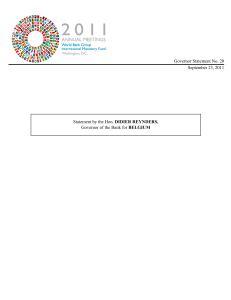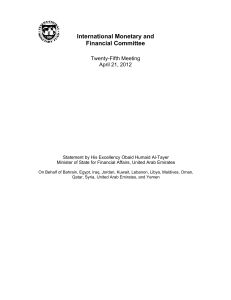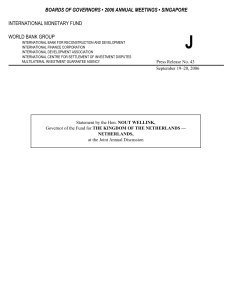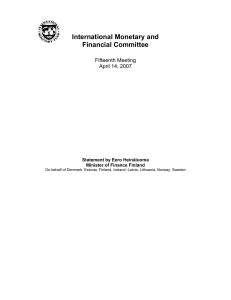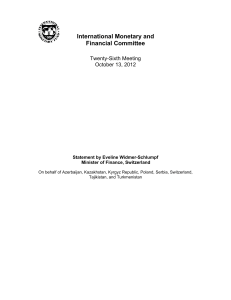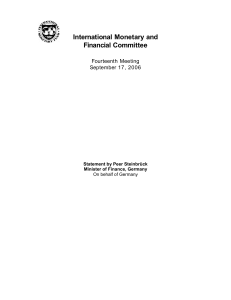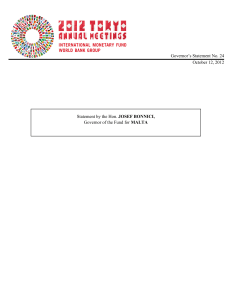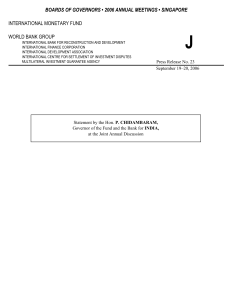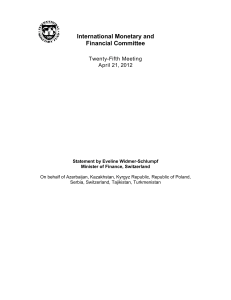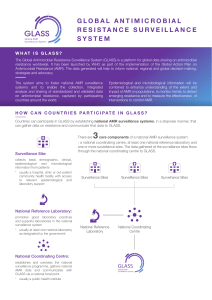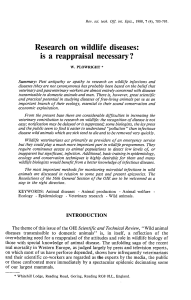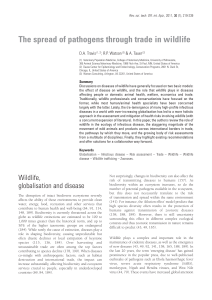Accepted article
publicité
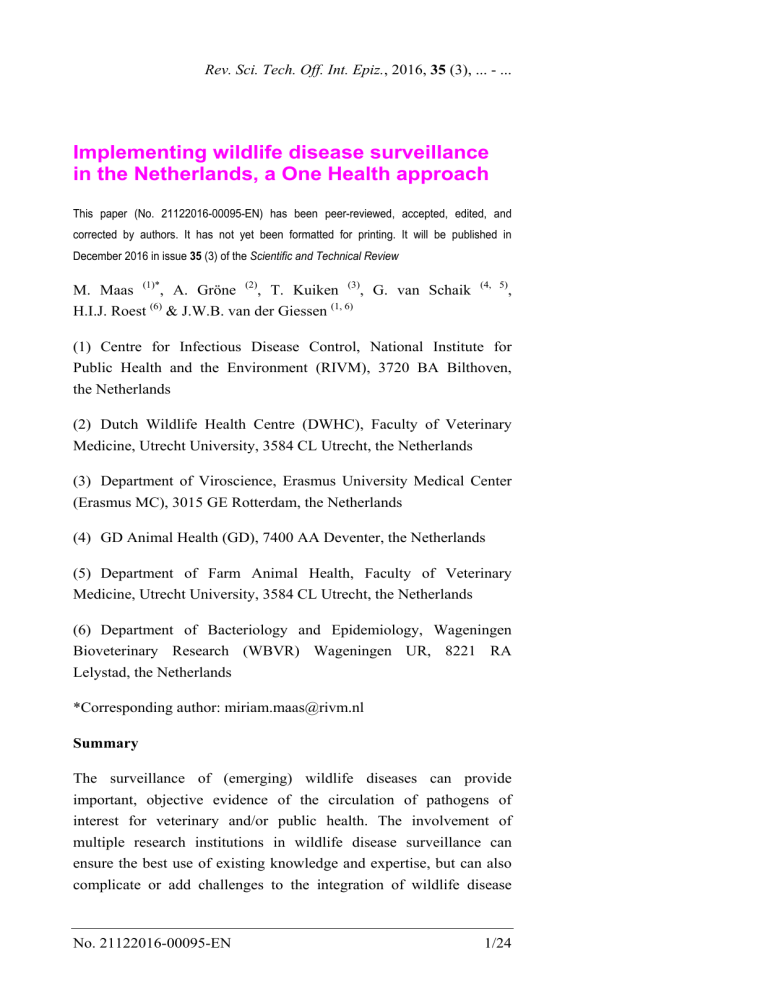
Rev. Sci. Tech. Off. Int. Epiz., 2016, 35 (3), ... - ... Implementing wildlife disease surveillance in the Netherlands, a One Health approach This paper (No. 21122016-00095-EN) has been peer-reviewed, accepted, edited, and corrected by authors. It has not yet been formatted for printing. It will be published in December 2016 in issue 35 (3) of the Scientific and Technical Review M. Maas (1)*, A. Gröne (2), T. Kuiken (3), G. van Schaik H.I.J. Roest (6) & J.W.B. van der Giessen (1, 6) (4, 5) , (1) Centre for Infectious Disease Control, National Institute for Public Health and the Environment (RIVM), 3720 BA Bilthoven, the Netherlands (2) Dutch Wildlife Health Centre (DWHC), Faculty of Veterinary Medicine, Utrecht University, 3584 CL Utrecht, the Netherlands (3) Department of Viroscience, Erasmus University Medical Center (Erasmus MC), 3015 GE Rotterdam, the Netherlands (4) GD Animal Health (GD), 7400 AA Deventer, the Netherlands (5) Department of Farm Animal Health, Faculty of Veterinary Medicine, Utrecht University, 3584 CL Utrecht, the Netherlands (6) Department of Bacteriology and Epidemiology, Wageningen Bioveterinary Research (WBVR) Wageningen UR, 8221 RA Lelystad, the Netherlands *Corresponding author: [email protected] Summary The surveillance of (emerging) wildlife diseases can provide important, objective evidence of the circulation of pathogens of interest for veterinary and/or public health. The involvement of multiple research institutions in wildlife disease surveillance can ensure the best use of existing knowledge and expertise, but can also complicate or add challenges to the integration of wildlife disease No. 21122016-00095-EN 1/24 Rev. Sci. Tech. Off. Int. Epiz., 35 (3) 2 surveillance components into a national programme. Documenting the existing efforts in a country’s surveillance of wildlife diseases, including the institutes in which it takes place, provides a basis for policy-makers and authorities to identify gaps and priorities in their current surveillance programmes. This paper describes the wildlife disease surveillance activities taking place in the Netherlands. The authors recommend that, in addition to funding these current activities, surveillance resources should be allocated with the flexibility to allow for additional targeted surveillance, to detect and adequately respond to newly introduced or emerging pathogens. Similar structured overviews of wildlife disease surveillance in other countries would be very useful to facilitate international collaboration. Keywords One Health – Overview – Public health – Surveillance – The Netherlands – Veterinary health – Wildlife disease. Introduction Wildlife serves as an important reservoir for infectious agents that cause (emerging) infectious diseases (1, 2). Many pathogens and toxins that cause wildlife diseases are also a potential risk to public health, to the health of domesticated animals and/or to the survival of the wildlife population itself – thus also posing a potential ecological risk. The surveillance of infectious organisms in wildlife can provide important, objective evidence of the circulation of pathogens that are significant for veterinary or public health. In the Netherlands, 86 emerging zoonoses have been ranked, using a risk score based on seven weighted criteria. One outcome of this action has been recognition of the importance of wildlife, since 85% of the 86 prioritised pathogens are related to wildlife (3, 4). As a result of the large array of agents that can affect or infect wildlife, their various characteristics, and the multiple species involved, surveillance of wildlife diseases and pathogens is often performed by a range of different research institutes and management authorities within a country. This can impede the integration of No. 21122016-00095-EN 2/24 Rev. Sci. Tech. Off. Int. Epiz., 35 (3) 3 information from wildlife disease surveillance activities and may result in the sub-optimal use of samples and funding. This paper therefore provides an overview of current wildlife disease surveillance activities in the Netherlands. It does not give detailed information of particular activities, and readers are referred to the relevant institutes for this information. This overview will be especially of interest to colleagues working on wildlife diseases, to facilitate national and international collaboration, as well as to policy-makers and veterinary authorities who wish to evaluate or restructure the organisation of their wildlife disease research. The documentation of existing national efforts for the surveillance of wildlife diseases is a crucial first step for such a task. In this paper, the authors use the term ‘wildlife disease surveillance’ to cover surveillance of both diseases and their causative (non-) infectious pathogens. These pathogens, including vector-borne pathogens, may cause disease in wildlife, or have wildlife as their reservoir and cause disease in either domestic animals and/or humans. The paper first describes the expertise and scope of the institutes involved with wildlife disease surveillance. The authors then discuss the various wildlife disease surveillance activities carried out at these institutes for species or groups of species. Similar overviews from other countries may serve as useful inputs to harmonise wildlife disease surveillance across boundaries and to facilitate international collaboration. Scope Although the broader scope of maintaining healthy and viable wildlife populations is inextricably linked with other field activities, such as monitoring wildlife populations and ecological research, the focus of this analysis is on the surveillance of ‘diseases’ of wildlife, caused by either infectious pathogens (e.g. Brucella suis) or non-infectious pathogens (e.g. lead intoxication). Surveillance is defined as the systematic ongoing collection, collation and analysis of information related to animal health, and the timely No. 21122016-00095-EN 3/24 Rev. Sci. Tech. Off. Int. Epiz., 35 (3) 4 dissemination of this information so that action can be taken (5). It aims to demonstrate the absence of disease or infection, determine the presence or distribution of disease or infection, or detect exotic or emerging diseases as early as possible. Surveillance can be divided into targeted (active) surveillance and general (also called passive or non-targeted) surveillance. Active surveillance is performed to obtain information about a particular pathogen in a particular host animal population, and generally involves collecting samples according to a statistical or probability-based sampling plan. General surveillance includes the pathological examination of animals found moribund or dead (6). In the Netherlands, there are several targeted surveillance programmes that periodically (e.g. annually) monitor a pre-defined number of wild animals. These target mainly World Organisation for Animal Health (OIE)-listed pathogens or pathogens that are important in the livestock farming industry; for example, classical swine fever virus in wild boar. Long-term research programmes that conduct targeted surveillance in a less strict sense are included in this overview. These programmes typically perform sampling only in high-risk areas, or by using samples collected opportunistically, and several years may intervene between consecutive surveys. They have a duration of more than one year, or are expected to extend beyond one year. Studies on the diseases of free-ranging domestic animal species, such as Konik horses or Heck cattle in Dutch nature reserves, were excluded from this overview. Wildlife in the Netherlands The Netherlands is a densely populated country, with about 17 million people living on 33,883 km2 of land. The land is shared with large numbers of livestock, e.g. 1.6 million cattle, 20 million pigs, and much wildlife, including large species such as red foxes, wild boar and deer and many species of small animals. No country-wide registration of wildlife populations exists in the Netherlands; however, in general, wildlife populations are increasing, due to, for example, a reduction in pollution, national and international agreements on No. 21122016-00095-EN 4/24 Rev. Sci. Tech. Off. Int. Epiz., 35 (3) 5 habitat conservation and wildlife corridors, and an increased societal awareness of wildlife preservation. Contacts between wildlife and humans or livestock kept outdoors are inevitable, due to the small, shared living environment. These contacts may facilitate the spread of pathogens to or from wildlife. Year by year this results in, for instance, several human hantavirus patients; the first diagnosis in 2008 of human alveolar echinococcosis cases after the introduction of Echinococcus multilocularis in red foxes; the re-emergence of tularemia; and the transmission of avian influenza virus from wild birds to poultry. This underlines the importance of wildlife disease surveillance in the Netherlands. Institutes involved in surveillance In the Netherlands, the surveillance of wildlife diseases and pathogens is coordinated by the Dutch Wildlife Health Centre (DWHC), based at the Faculty of Veterinary Medicine, Utrecht University. The DWHC plays a central role in early warning of wildlife disease. This is achieved primarily by thorough pathological examination to determine the possible causes of unusual or unexplained wildlife mortalities and specialised follow-up research among a network of affiliated institutions (incident investigation). In addition, one of the important aims of the DWHC is to aggregate all wildlife surveillance information, so that the results can be reported to the OIE, and to improve collaboration between institutes that have already developed expertise in certain fields or have specific responsibilities for wildlifeborne diseases or pathogens. Other institutes that have specific, legally imposed responsibilities for animal and public health are Wageningen Bioveterinary Research of Wageningen University and Research Centre (UR) (WBVR), the National Institute for Public Health and the Environment (RIVM), the Erasmus Medical Center (Erasmus MC) and GD Animal Health (GD). These institutes each have a specific responsibility for wildlife diseases and pathogens but collaborate in many surveillance and research activities. No. 21122016-00095-EN 5/24 Rev. Sci. Tech. Off. Int. Epiz., 35 (3) 6 The WBVR is the National Reference Laboratory for Notifiable Animal Diseases, including many of those that are relevant to wildlife. It plays an active role in research into and the surveillance and prevention of several notifiable and/or zoonotic diseases, especially where livestock are involved. In addition, for many years, one of its statutory tasks has been the diagnosis of unexplained wildlife mortalities, possibly caused by illegal activities, with a special emphasis on birds of prey. The Centre for Infectious Disease Control (RIVM) coordinates the control of infectious diseases in humans and is the National Reference Laboratory for, among others, zoonotic and foodborne parasitic diseases. The RIVM has an active role in monitoring those wildlife zoonoses that are not of relevance for the wildlife population itself, nor for livestock, but are purely of zoonotic interest. The Department of Viroscience at the Erasmus MC is the National Reference Laboratory for Influenza and the World Health Organization (WHO) Collaborating Centre for Arboviruses and Haemorrhagic Fever Viruses. The Erasmus MC has a central role in monitoring avian influenza virus by targeted surveillance of living wild birds (alongside the non-targeted surveillance carried out at the WBVR on wild birds that are found dead). The Erasmus MC is also involved in discovering and monitoring zoonotic viral infections in wildlife. GD Animal Health carries out national health surveillance on farm animals, commissioned by the Dutch government and the livestock industry. Surveillance is carried out to detect livestock diseases that, in general, are also very relevant to wildlife health. GD also regularly executes projects on wildlife diseases in specific regions (e.g. provinces or national parks). A few institutes also play a minor role in wildlife disease surveillance, including private laboratories, the Royal Tropical Institute and the Institute for Strategic and Applied Marine Ecology. Recently, the Netherlands Centre for One Health started a collaborative research network in which, among others, the DWHC, CVI, RIVM and No. 21122016-00095-EN 6/24 Rev. Sci. Tech. Off. Int. Epiz., 35 (3) 7 Erasmus MC apply their research within the overarching theme of ‘Healthy Wildlife and Ecosystems’. Wildlife disease surveillance in the Netherlands The flow charts in Figure 1a to Figure 1f illustrate wildlife disease surveillance in the Netherlands for wild boar, wild carnivores, rodents, cervids, lagomorphs and birds. No flow charts are given for bats, marine mammals, reptiles/amphibians or fish and molluscs, since only a limited number of institutes or pathogens are involved; however, their disease surveillance is described. This overview is organised around taxonomy, choosing the lowest scientific classification possible. For instance, since no other wild suids are studied in the Netherlands, a flow chart was designed for wild boar only. However, various rodent families are studied, so a rodent flow chart was designed. The flow charts indicate those institutes that are involved (through colour), and responsible for the storage and analysis of relevant data. The surveillance of specific pathogens in wild boar (Fig. 1a) has been continuing for decades, as they are a reservoir for various pathogens that may affect the pig-farming industry. As wild boar are also hunted for meat, additional regulations are in place for approving the meat for consumers. Although Mycobacterium bovis is emerging in wild boar in some European countries, e.g. France (7), Dutch policy-makers are still discussing whether M. bovis should be included in a targeted surveillance system, since it has not yet been detected in the Netherlands. Testing wild boar for foot and mouth disease virus and swine vesicular disease virus was discontinued in 2015. The flow chart of wild carnivores (Fig. 1b) contains red foxes (Vulpes vulpes), European badgers (Meles meles) and other Dutch carnivores, e.g. Mustelidae. Red foxes are the main reservoir species of rabies, thus specific protocols are in place for this species. However, other carnivores exhibiting suspicious behaviour or showing suspicious lesions during post-mortem examination are also tested for rabies. Additional short-term research programmes have been carried out on these species, e.g. deep sequencing for virus discovery in red foxes No. 21122016-00095-EN 7/24 Rev. Sci. Tech. Off. Int. Epiz., 35 (3) 8 (carried out by the Erasmus MC in collaboration with the RIVM), pine martens (Martes martes) and European badgers (by the Erasmus MC, in collaboration with Wageningen Environmental Research [Alterra] and the Dutch Mammal Society) (8). There is no targeted surveillance for morbilliviruses (specifically, canine distemper virus), although this has been reported in the Netherlands. Surveillance of various small rodent species (Fig. 1c), e.g. bank voles (Myodes glareolus), common voles (Microtus arvalis), yellow-necked mice (Apodemus flavicollis), brown rats (Rattus norvegicus) and black rats (Rattus rattus) is ongoing in the Netherlands. Research on these species is coordinated by the RIVM and the practical work is performed at the RIVM and WBVR. Other rodent species, for example muskrats (Ondatra zibethicus), are examined by the DWHC. The RIVM does implement some projects to detect pathogens in rats, e.g. Toxoplasma gondii, methicillin-resistant Staphylococcus aureus and Coxiella burnetii. These are usually cross-sectional studies lasting from several months to a year. Wildlife disease surveillance of cervids includes roe deer (Capreolus capreolus), red deer (Cervus elaphus), and fallow deer (Dama dama) (Fig. 1d). There are currently no nationwide active surveillance schemes involving cervid diseases. However, each year, GD receives convenience samples of hunted red deer from the Oostvaardersplassen nature reserve for pathology, serology and faecal testing (ten animals in total), for specific diseases, such as bluetongue virus, Brucella spp., bovine viral diarrhoea virus (BVDV) and paratuberculosis (also known as Johne’s disease). Short, targeted studies to detect the presence of specific pathogens have been conducted at the WBVR (for M. bovis, foot and mouth disease virus, bluetongue virus, Schmallenberg virus, C. burnetii and hepatitis E virus) and at the RIVM (hepatitis E virus). Targeted surveillance of C. burnetii in pregnant cervids and M. bovis in cervids may be valuable additions to surveillance systems in the future. GD implemented a project for the province of Gelderland on the SouthEast Veluwe (an extensive forest area) from 2008–2010 in which No. 21122016-00095-EN 8/24 Rev. Sci. Tech. Off. Int. Epiz., 35 (3) 9 hunted roe, red and fallow deer were sampled and tested for several infectious pathogens, such as B. abortus, C. burnetii, Leptospira hardjo, Salmonella spp., bluetongue virus, bovine herpesvirus-1, BVDV, Fasciola hepatica (liver fluke), Babesia spp. and Anaplasma spp. The causes of death or disease in hares (Lepus europaeus) and rabbits (Oryctolagus cuniculus) are investigated at the DWHC (Fig. 1e). From 2011 to 2015, spleens and livers of hares that had been hunted or found dead, but were not considered suitable for consumption, were routinely submitted to the WBVR and analysed for the presence of Francisella tularensis, the causative agent of tularemia. At present, samples are still sent to the WBVR, but only when tularemia is suspected. Liver samples are sent to the Erasmus MC and analysed for the presence of European brown hare syndrome virus. Recently, an outbreak of rabbit haemorrhagic disease was detected by the DWHC and the causative agent (RHDV variant 2) was identified, in cooperation with the Friedrich-Loeffler-Institute in Germany. The DWHC, in collaboration with the WBVR and the Netherlands Food and Consumer Product Safety Authority (NVWA), has developed a protocol to investigate the cause of death in birds (www.dwhc.nl/wpcontent/uploads/2016/01/Vogelsterfteschema_2016.pdf) (Fig. 1f). Targeted surveillance is carried out on birds for avian influenza. In cases of mortality in a single area above the threshold (>3 dead water birds, or >20 birds other than water birds), the NVWA collects the dead birds, which are subsequently tested for avian influenza virus at the WBVR. Pharyngeal and cloacal swabs from live birds, predominantly ducks, geese and gulls, are analysed for avian influenza at the Erasmus MC in Rotterdam, which also coordinates the capture of these birds. A blood sample is taken from a proportion of the birds. The WBVR also tests for botulism and toxins in cases of suspected malicious poisoning. The WBVR is also involved in testing samples from animal cases of psittacosis (Chlamydia psittaci) or to track the source of human cases. Other causes of death or disease in wild birds are investigated at the DWHC, and, depending on the suspected No. 21122016-00095-EN 9/24 Rev. Sci. Tech. Off. Int. Epiz., 35 (3) 10 pathogen, samples are further analysed at other institutes, e.g. West Nile virus and Usutu virus are sent to the RIVM. Bats involved in contact incidents with humans are submitted to the WBVR and tested for European bat lyssavirus 1 and 2 (EBLV-1 and EBLV-2) within 24 hours with the fluorescent antibody test on brain smears. Tissues from these bats are stored in a tissue bank at the WBVR. Bats found dead or grounded, which were not involved in contact incidents with humans, are submitted to the DWHC, where gross pathology and histopathology are performed, and where a selection of samples is stored in a tissue bank. Short-term research projects are performed at the WBVR, RIVM and Erasmus MC on coronavirus and other viruses in bats. Marine mammals are not directly within the scope of the DWHC, but their cause of death and disease status are evaluated at the Department of Pathobiology of the Faculty of Veterinary Medicine, Utrecht. Gross pathology and histopathology of harbour porpoises, seals and other species are performed at the DWHC and samples are stored in tissue banks. Recently, the DWHC became involved in the post-mortem examination of stranded whales. In collaboration with the WBVR, the DWHC has conducted tissue testing of seals and harbour porpoises for Brucella spp. during two short-term projects. The Institute for Marine Resources and Ecosystem Studies (IMARES) studies the stomach contents of harbour porpoises for food analysis. In addition, the Erasmus MC collaborates with the Seal Rehabilitation and Research Centre in Pieterburen and the Dolfinarium in Harderwijk on a number of different research topics, including morbidity and mortality factors of seals (9) and live, stranded cetaceans; viral diseases such as influenza (10) and phocine distemper (11, 12); and bacterial diseases such as staphylococcosis (13). Disease surveillance of reptiles and amphibians is carried out at the DWHC, where gross pathology and histopathology are conducted on reptiles and amphibians that have been found dead. Tissue samples are stored in a tissue bank. Since 2010, ranavirus has been recognised as a potential threat to Dutch amphibian populations and submitted No. 21122016-00095-EN 10/24 Rev. Sci. Tech. Off. Int. Epiz., 35 (3) 11 animals are routinely screened for the presence of the virus. The DWHC also analyses the role of a fungus recently identified in the Netherlands reptile population, Chrysosporium anamorph of Nannizziopsis vriesii (CANV), by – among other things – determining the cause of death of reptiles which are found dead. Disease surveillance of fish includes freshwater, brackish water and marine fish species and is performed at the WBVR. Whole dead fish are brought to the WBVR for gross pathology and histopathology and tested for botulism, especially when dead birds are found in the same water basin. For suspicions of notifiable diseases, e.g. epizootic haematopoietic necrosis, infectious haematopoietic necrosis, infectious salmon anaemia, koi herpes virus and viral haemorrhagic septicaemia, there are strict protocols with mandatory testing. For live but diseased fish, the tests are chosen based on clinical pathology and diagnostic possibilities. These tests may also include tests for notifiable animal diseases. Moreover, the National Reference Laboratory for Parasites, including Anisakis, is within the RIVM and thus regularly receives fish intended for human consumption from consumers or NVWA, for specification of fish pathogen species. There is an active surveillance scheme for mollusc diseases, targeting oysters (Ostrea edulis and Crassostrea gigas) and mussels (Mytilus edulis). Twice a year, for health surveillance purposes, and in the case of unexplained mollusc mortalities, the National Reference Laboratory for Shellfish Diseases, WBVR, collects live molluscs from shellfish culture areas, in accordance with European Union (EU) legislation on animal health requirements for aquaculture animals and products (14). This is done in collaboration with fisheries inspectors and Wageningen Marine Research (of Wageningen UR). The WBVR analyses these molluscs, using real-time quantitative polymerase chain reaction and histopathology, for mollusc diseases notifiable to the European Commission, e.g. Bonamia ostreae, B. exitiosa, Marteilia refringens and Mikrocytos mackini. In cases of increased mortality, samples are collected by veterinary authorities in collaboration with No. 21122016-00095-EN 11/24 Rev. Sci. Tech. Off. Int. Epiz., 35 (3) 12 Fisheries Inspectors and the collected specimens are analysed at the WBVR. Molluscs are also tested for pathogens at the RIVM, which is also the National Reference Laboratory for Microbiological Contamination of Bivalve Molluscs, and performs official research tasks on shellfish animal health. At the National Reference Laboratory, blue mussels, oysters, common cockles (Cerastoderma edule) and razor clams (Ensis) are tested for Escherichia coli, which serves as an indicator pathogen for faecal contamination with viruses and Salmonella spp. Detection of specific pathogens in multiple wildlife species and vectors Surveillance strategies may differ for pathogens that affect a wide range of animal species, compared to pathogens that involve only one species. For example, M. bovis is found in multiple species and can result in significant economic losses when livestock are infected. Since M. bovis is emerging in badgers in the United Kingdom and France (7), the pathogen was included in Dutch targeted surveillance of badgers from 2012–2014 at the DWHC, but has not yet been included for wild boar and cervids. However, suspicious lesions found during necropsies of wild boar and cervids, i.e. during general surveillance, will be further investigated and samples sent to the WBVR for confirmation. Vector-borne wildlife pathogens are also often associated with multiple animal species. Therefore, for some pathogens, studying the vector itself may be a more effective surveillance strategy than monitoring the pathogen in one species. Long-term studies have been carried out by the RIVM on Ixodes ricinus and the various pathogens carried by this tick, e.g. Borrelia burgdorferi s.l., Anaplasma phagocytophilum, Neoehrlichia mikurensis, Rickettsia spp. and Babesia spp. For other pathogens that may occur in I. ricinus and mosquitoes, short-term ad hoc studies have been conducted, e.g. for B. miyamotoi, C. burnetii and Bartonella spp, and arboviruses, respectively. Parts of these studies were carried out in collaboration with the Dutch National Centre for Monitoring of Vectors. Monitoring No. 21122016-00095-EN 12/24 Rev. Sci. Tech. Off. Int. Epiz., 35 (3) 13 midges, the vectors for bluetongue virus and Schmallenberg virus, among others, is carried out by the WBVR in collaboration with international partners. Key features of current surveillance systems in the Netherlands Key to wildlife disease surveillance programmes in the Netherlands is the close collaboration among the various institutes, which provides strong links between wildlife health, human health, companion animal health and livestock health. This enables them to respond quickly to infectious disease signals from both the human and animal domains and to investigate possible links with wildlife. This collaboration is based on both legal and non-legal obligations, such as the obligations of the National Reference Laboratories and reporting OIE-listed diseases, but also largely depends on voluntary cooperation. One potential limitation is that the involvement of different institutes requires strong collaboration from all the partners to prevent institutes from working in isolation. Depending on this ongoing wildlife surveillance and its results, the institutes make direct contact with one another, often involving two or three institutes at the same time. To formally assess the risks of emerging zoonotic signals, including those from wildlife, an integrated human–veterinary risk analysis structure was implemented in 2011. The first link in the chain of this structure was the establishment of the national Signalling Forum Zoonoses (SOZ). This forum includes the main veterinary and public health institutes involved in surveillance and control of infectious diseases. This legal entity meets monthly and follows the public health infectious diseases control structure, with the additional involvement of the relevant veterinary institutes and authorities, including relevant stakeholders, in case the private agricultural sector needs to become involved. All signs of zoonotic disease that deviate from what is usually seen, including those in wildlife, are assessed, as well as their implications. In the SOZ, most of the institutes mentioned above are represented, further strengthening intersectoral collaboration. So, for example, when an increase in the prevalence of E. multilocularis was observed in the south of the Netherlands in 2013, the implications of No. 21122016-00095-EN 13/24 Rev. Sci. Tech. Off. Int. Epiz., 35 (3) 14 this and any potential action were discussed in the forum, resulting in communications aimed at veterinarians and general practitioners in this part of the country. There are no strict guidelines on decisionmaking, and it is the responsibility of the partners of the SOZ to decide on any potential follow-up. When a notifiable animal disease is suspected, the Netherlands Food and Consumer Product Safety Authority, which includes the Dutch Veterinary Services, is contacted immediately and (European) legislation is then followed. Collaboration between the institutes described above is crucially important; however, they also need to collaborate with related institutes that take an interest in wildlife from other (ecological) perspectives. Combining knowledge of pathogens in wildlife populations with knowledge of other aspects of wildlife populations, such as their numbers, distribution, and ecology, is vital when risk assessments for wildlife diseases must be performed. In the Netherlands, the DWHC is the primary partner, bridging the gap between disease knowledge and ecosystem knowledge by initiating close collaborations with diverse institutes that have ecological expertise. These can range from collaborative research projects to organising training for hunters in wildlife diseases and hygiene. Another limitation to the involvement of multiple research institutes is that resources for wildlife surveillance must be divided among the institutes concerned, which complicates the re-allocation of resources when this proves necessary, e.g. in the case of an emerging disease. On the other hand, the involvement of expert institutes in various components of surveillance may also reduce costs, as surveillance can be incorporated into the other activities of the institutes. The current budgets for targeted and long-term surveillance programmes may not be sufficient to respond to newly introduced pathogens, for instance, the need to test for new pathogens using stored samples or to take additional samples during post-mortem examination. To respond adequately to newly introduced pathogens, part of the surveillance budget must be allocated with some flexibility, alongside the continuing and more established surveillance No. 21122016-00095-EN 14/24 Rev. Sci. Tech. Off. Int. Epiz., 35 (3) 15 programmes. When deciding on the budget for wildlife disease surveillance, the authors recommend that the effectiveness of such surveillance be balanced against its costs – a task which often depends on the context. For example, sometimes samples are taken from a species that is less valuable for pathogen detection but much easier to sample because it is already included in other surveillance programmes. European situation Wildlife diseases do not stop at borders. Thus, it is important for neighbouring countries to cooperate in the assessment of wildlife diseases and pathogens and to determine potential (future) threats and gaps in surveillance. In Europe, increasing numbers of research projects and wildlife disease surveillance programmes are being implemented, examining over 18,000 wild animals annually during general surveillance programmes and over 50,000 wild animals in the course of targeted surveillance (15). However, wildlife disease surveillance programmes can differ greatly between countries. European networks have been established to improve surveillance across borders and to harmonise surveillance activities and diagnostic methods. The European Wildlife Disease Association, the regional association under the umbrella of the global Wildlife Disease Association, provides a Web-based network to communicate new findings related to wildlife diseases and pathogens in Europe, thus acting as an early warning network (https://groups.google.com/forum/#!forum/ewda-network). Various projects have also been undertaken over recent years to improve wildlife disease surveillance on a European scale, e.g. ‘WildTech’ and the project ‘harmonised Approaches in monitoring wildlife Population Health, And Ecology and Abundance’ (APHAEA). ‘WildTech’ was a project of the EU Seventh Framework Programme for Research and Technological Development, with the aim of developing new diagnostic methods for wildlife diseases. APHAEA was a project of the Coordination of European Research on Emerging and Major Infectious Diseases of Livestock (EMIDA), No. 21122016-00095-EN 15/24 Rev. Sci. Tech. Off. Int. Epiz., 35 (3) 16 which was a European Research Area Network (ERA-NET) initiative. Its aim was to establish a European wildlife disease surveillance network that is capable of providing reliable estimates of the abundance of wildlife species, and of pathogen distribution in key wildlife species (www.aphaea.org). Those institutes involved in wildlife surveillance in the Netherlands have participated in these European initiatives, according to their expertise. Conclusions There is a pressing need for international awareness of wildlife disease surveillance programmes in different countries. Wildlife disease surveillance in the Netherlands is performed across various institutes, each of which has its own area of expertise. The involvement of multiple institutes in the surveillance of wildlife disease ensures the best use of the existing knowledge, available expertise and allocated funds, but requires close collaboration between these institutions. The overview of wildlife disease surveillance in the Netherlands presented here is intended as a starting-point, to facilitate both national and international collaboration. Acknowledgements This overview was extracted from a position paper, written with the help of many people at various institutions. The authors would like to thank Wim van der Poel (WBVR), Jolianne Rijks (DWHC), Peter van Tulden (WBVR), Clazien de Vos (WBVR), Marieta Braks (RIVM), Hein Sprong (RIVM), and Chantal Reusken (RIVM, currently working at the Erasmus MC), for critically reading the manuscript. They would also like to acknowledge Ad Moen (GD), Olga Haenen (WBVR), Irene Pol (RIVM) and Judith van den Brand (Erasmus MC) for their comments on the manuscript and their contributions to the overview of wildlife disease surveillance in the Netherlands. This work was financed by the Netherlands Food and Consumer Product Safety Authority. No. 21122016-00095-EN 16/24 Rev. Sci. Tech. Off. Int. Epiz., 35 (3) 17 References 1. Jones K.E., Patel N.G., Levy M.A., Storeygard A., Balk D., Gittleman J.L. & Daszak P. (2008). – Global trends in emerging infectious diseases. Nature, 451 (7181), 990–993. doi:10.1038/nature06536. 2. Haydon D.T., Cleaveland S., Taylor L.H. & Laurenson M.K. (2002). – Identifying reservoirs of infection: a conceptual and practical challenge. Emerg. Infect. Dis., 8 (12), 1468–1473. doi:10.3201/eid0812.010317. 3. Havelaar A.H., van Rosse F., Bucura C., Toetenel M.A., Haagsma J.A., Kurowicka D., Heesterbeek J.H., Speybroeck N., Langelaar M.F., van der Giessen J.W., Cooke R.M. & Braks M.A. (2010). – Prioritizing emerging zoonoses in the Netherlands. PLoS ONE, 5 (11), e13965. doi:10.1371/journal.pone.0013965. 4. Van der Giessen J.W.B., Van de Giessen A.W. & Braks M.A.H. (2010). – Emerging zoonoses: early warning and surveillance in the Netherlands. RIVM Report 330214002. National Institute for Public Health and the Environment (RIVM), Bilthoven, the Netherlands, 168 pp. Available at: www.rivm.nl/bibliotheek/rapporten/330214002.pdf (accessed on 25 November 2016). 5. World Organisation for Animal Health (OIE) (2015). – Terrestrial Animal Health Code, 24th Ed. Chapter 1.4. OIE, Paris. Available at: www.oie.int/index.php?id=169&L=0&htmfile=chapitre_surveillance_ general.htm (accessed on 4 December 2015). 6. World Organisation for Animal Health (OIE) (2010). – Training manual on wildlife diseases and surveillance, 1st Ed. OIE, Paris. Available at: www.oie.int/fileadmin/Home/eng/Internationa_Standard_Setting/docs /pdf/WGWildlife/A_Training_Manual_Wildlife.pdf (accessed on 4 December 2015). No. 21122016-00095-EN 17/24 Rev. Sci. Tech. Off. Int. Epiz., 35 (3) 18 7. Gortazar C., Delahay R.J., McDonald R.A., Boadella M., Wilson G.J., Gavier-Widen D. & Acevedo P. (2012). – The status of tuberculosis in European wild mammals. Mammal Rev., 42 (3), 193– 206. doi:10.1111/j.1365-2907.2011.00191.x. 8. Van den Brand J.M., Van Leeuwen M., Schapendonk C.M., Simon J.H., Haagmans B.L., Osterhaus A.D. & Smits S.L. (2012). – Metagenomic analysis of the viral flora of pine marten and European badger feces. J. Virol., 86 (4), 2360–2365. doi:10.1128/JVI.06373-11. 9. Osinga N., Shahi Ferdous M.M., Morick D., Garcia Hartmann M., Ulloa J.A., Vedder L., Udo de Haes H.A., Brakefield P.M., Osterhaus A.D. & Kuiken T. (2012). – Patterns of stranding and mortality in common seals (Phoca vitulina) and grey seals (Halichoerus grypus) in the Netherlands between 1979 and 2008. J. Comp. Pathol., 147 (4), 550–565. doi:10.1016/j.jcpa.2012.04.001. 10. Bodewes R., Morick D., de Mutsert G., Osinga N., Bestebroer T., van der Vliet S., Smits S.L., Kuiken T., Rimmelzwaan G.F., Fouchier R.A. & Osterhaus A.D. (2013). – Recurring influenza B virus infections in seals. Emerg. Infect. Dis., 19 (3), 511–512. doi:10.3201/eid1903.120965. 11. Bodewes R., Morick D., van de Bildt M.W., Osinga N., Rubio Garcia A., Sanchez Contreras G.J., Smits S.L., Reperant L.A., Kuiken T. & Osterhaus A.D. (2013). – Prevalence of phocine distemper virus specific antibodies: bracing for the next seal epizootic in north-western Europe. Emerg. Microbes Infect., 2 (1), e3. doi:10.1038/emi.2013.2. 12. Van Elk C.E., van de Bildt M.W., Jauniaux T., Hiemstra S., van Run P.R., Foster G., Meerbeek J., Osterhaus A.D. & Kuiken T. (2014). – Is dolphin morbillivirus virulent for white-beaked dolphins (Lagenorhynchus albirostris)? Vet. Pathol., 51 (6), 1174–1182. doi:10.1177/0300985813516643. No. 21122016-00095-EN 18/24 Rev. Sci. Tech. Off. Int. Epiz., 35 (3) 19 13. Van Elk C.E., Boelens H.A., van Belkum A., Foster G. & Kuiken T. (2012). – Indications for both host-specific and introduced genotypes of Staphylococcus aureus in marine mammals. Vet. Microbiol., 156 (3–4), 343–346. doi:10.1016/j.vetmic.2011.10.034. 14. European Union (2006). – Council Directive 2006/88/EC of 24 October 2006 on animal health requirements for aquaculture animals and products thereof, and on the prevention and control of certain diseases in aquatic animals. Off. J. EU, L 328, 24.11.2006, 14– 56. Available at: http://eur-lex.europa.eu/legalcontent/EN/ALL/?uri=CELEX%3A32006L0088 (accessed on 19 December 2006). 15. Kuiken T., Ryser-Degiorgis M.P., Gavier-Widen D. & Gortazar C. (2011). – Establishing a European network for wildlife health surveillance. Rev. Sci. Tech. Off. Int. Epiz., 30 (3), 755–761. Available at: www.oie.int/en/publications-anddocumentation/scientific-and-technical-review-free-access/list-ofissues/ (accessed on 23 November 2016). doi:10.20506/rst.30.3.2067. __________ No. 21122016-00095-EN 19/24 Rev. Sci. Tech. Off. Int. Epiz., 35 (3) 20 DWHC: Dutch Wildlife Health Centre WBVR: Wageningen Bioveterinary Research RIVM: National Institute for Public Health and the Environment GD: GD Animal Health Erasmus MC: Erasmus Medical Center Other institutes Z: concerns a zoonotic pathogen * Qualified hunters assess the carcass in the field; approved carcasses go for general meat inspection, condemned carcasses in the field are investigated at the DWHC Wild boar Hunted - Targeted surveillance Classical swine fever (serum, tonsils) Trichinella (Z) (serum) Aujeszky disease (serum) Brucella suis (Z) (tonsils) Brucella suis (Z) (serum) African swine fever (serum) Hunted - General surveillance (hunters*) Approved: general meat inspection Trichinella (Z) (digestion; routine labs) Found dead Condemned: carcass/organs Gross pathology Histopathology Tissue bank Classical swine fever a) Wild boar No. 21122016-00095-EN Gross pathology Histopathology 20/24 Rev. Sci. Tech. Off. Int. Epiz., 35 (3) 21 Wild carnivores Red foxes Badgers Hunted – Targeted surveillance Hunted - General surveillance (if abnormal behaviour) Rabies (Z) (brain) Echinococcus multilocularis (Z) (intestines) Other species Found dead Found dead Gross pathology Histopathology Gross pathology Histopathology Trichinella (Z) (muscle) Tissue bank Tissue bank Mycobacterium bovis (Z) (lungs) Tissue bank Baylisascaris melis (Z) (intestines) b) Wild carnivore Rodents Mice/voles Rats (brown/black) Other species Targeted surveillance (incl. live capture) Targeted surveillance (incl. live capture) Gross pathology Histopathology Puumala and Tula hantavirus (Z) (serum, lungs) Seoul hantavirus (Z) (serum, lungs) Leptospira (Z) (serum) Tissue bank Leptospira (Z) (kidney) (KIT) Trichinella (Z) (muscle) Tissue bank c) Rodents No. 21122016-00095-EN 21/24 Tissue bank Found dead Gross pathology Histopathology Tissue bank Rev. Sci. Tech. Off. Int. Epiz., 35 (3) 22 Cervids Hunted – Targeted surveillance Bluetongue virus (serum) Brucella (Z (serum) BVDV (serum) IBR (serum) Leptospira (Z) (serum) Fasciola hepatica (Z) (serum) Gastrointestinal parasites (feces) Para TB (feces, serum) Salmonella spp. (Z) (serum) Gross pathology Histopathology Hunted – General surveillance (hunters*) Approved: general meat inspection Found dead Condemned: carcass/organs Gross pathology Histopathology d) Cervids No. 21122016-00095-EN 22/24 Gross pathology Histopathology Tissue bank Rev. Sci. Tech. Off. Int. Epiz., 35 (3) 23 Lagomorphs Hares Hunted – General surveillance (hunters*) Approved: meat inspection (poulterer) Condemned: carcass/organs Gross pathology Histopathology Rabbits Found dead Found dead Gross pathology Histopathology Gross pathology Histopathology Tissue bank Tissue bank Francisella tularensis (Z) (spleen, liver) European brown hare syndrome (liver) e) Lagomorphe No. 21122016-00095-EN 23/24 Hunted – General surveillance (hunters*) Approved: meat inspection (poulterer) Condemned: carcass/organs Gross pathology Histopathology Rev. Sci. Tech. Off. Int. Epiz., 35 (3) 24 Birds Water birds Birds captured alive Avian influenza (Z) (cloacal + pharyngeal swabs, blood) >3 found dead Avian influenza (Z) (cloacal swabs) Other species >20 found dead <3 found dead <20 found dead Avian influenza (Z) (cloacal swabs) Gross pathology Histopathology Gross pathology Histopathology Botulism (Z) (liver or serum) Botulism (Z) (liver or serum) Toxins (relevant organs) Toxins (relevant organs) Tissue bank Tissue bank f) Birds DWHC: Dutch Wildlife Health Centre RIVM: National Institute for Public Health and the Environment Erasmus MC: Erasmus Medical Center WBVR: Wageningen Bioveterinary Research GD: GD Animal Health Other institutes Z: concerns a zoonotic pathogen * Qualified hunters assess the carcass in the field; approved carcasses go for general meat inspection, condemned carcasses in the field are investigated at the DWHC Fig. 1 Flow charts of wildlife disease surveillance in the Netherlands The colour of the square indicates the institute involved. Tissue banking includes a selection of tissues/organs. This selection may differ per wildlife species or institute, but for most wildlife species it includes lungs, liver, spleen, kidneys and brain, as well as serum samples No. 21122016-00095-EN 24/24 Birds captured alive Avian influenza (Z) (cloacal + pharyngeal zwabs, blood)
